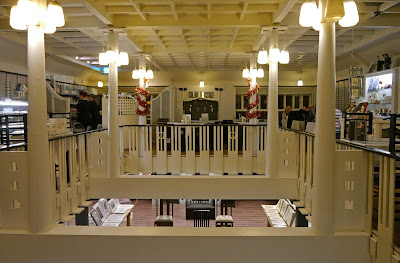The Mackintosh church
We are in Glasgow for a mini break with the principal aim of seeing as much of Charles Rennie Mackintosh's work as possible. We decided to start at the Mackintosh church at Queen's Cross, taking the metro to Cowcaddens and walking about a mile up Maryhill Road. The church was built for the Free Church of Scotland and the design brief required a simple design. It was completed in 1899 and became redundant in 1976. Soon after it became the headquarters of the Charles Rennie Mackintosh Society.
The exterior is quite squat and lumpy and has the unusual feature of a corner tower which becomes narrower as it goes up. It was apparently based on a Medieval church in Somerset and on Norman Shaw's Holy Trinity, Latimer Road. The irregularly placed windows are typical of Mackintosh.
Although looking rather austere from the outside, there are still some delightful flower motifs of the kind that Mackintosh incorporated in all his designs. This is a close up of the area above the main entrance (on the right of the exterior).
The interior seems fairly plain at first and is dominated by the wonderful "blue heart" window at the east end and by the barrel vault with its steel cross-beams.
Here is a close up of the window showing the unusual tracery and the variegated shades of blue as well as the stylised flowers beloved of Makintosh.
At the west end there is another stained glass window with more minimal stained glass.
There are also two galleries and scattered throughout the church, on the pulpit, on the capitals of the columns holding up the galleries, on doors and woodwork there are delightful floral details. They are quite unobtrusive and one wonders if Macintosh almost smuggled them in when the church.
We headed back down the hill and headed towards Renfrew St. Here is Mackintosh's most famous building, the Glasgow School of Art. It was built in two phases between 1896-99 and 1907-09. A serious fire in 2014 caused serious damage including the destruction of Mackintosh's famous library.
Approaching the building uphill from the east, it can be seen that about half it is swathed in scaffolding. The large windows light a series of studios and looking at the east end it is striking how one half is completely blank, while the other has a variety of windows, mouldings and a turreted staircase. This was a clear example of exterior design rigorously following internal function, and was quite controversial at the time.
This is a view of the front of the building with its famous entrance.
I have seen many pictures of the School of Art entrance, but what I hadn't previously spotted was the amount of ornamental ironwork, including fence posts and even a street lamp. The fence posts seem to be sprouting a clump of tulips.
From the School of Art it is only a short hop to Sauchiehall Street and the Willow Tea Rooms. This was converted from a warehouse in 1903 to designs by Mackintosh and his wife Margaret Macdonald. The client, Catherine (Kate) Cranston had four such enterprises in the city which provided places for people, especially women, to meet without the temptation of the demon drink. Mackintosh was involved in the design of all of these, but only the Willow Tea Room remains. Over time it was incorporated into a department store and became its tea room. It was refurbished in the 1980s.
The ground floor is now the gift shop, but the first floor houses one of two tea rooms. It is pale coloured with ladder-back chairs and geometrical and flower motifs.
The real glory of the Willow Tea Rooms however is the Room Deluxe on the second floor. This smallish square room is surrounded on three sides by an extraordinary frieze of purple glass in a elaborate leadwork design.
The chairs are more elaborate than downstairs and the window has exquisite stylised tulips, which are gold on the inside and silver outside (see the exterior photo above).
On the top floor is the former Billiard Room. This houses a small exhibition and has an original fireplace. But the best bit is the high window with this series of brilliant blue glass panels.
Conditions: rainy and cloudy.
Distance: no more than 3 miles.
Rating: five stars.













2 comments:
What a superb set of designs you found on this walk. Your trip looked very rewarding :)
Hi Paul. Thanks. It was was! I've read about Mackintosh, but it can't match seeing his works in the flesh. Peter
Post a Comment